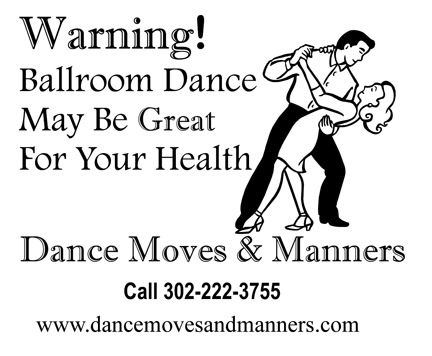Dancing and Your Health
Bored with your Treadmill? Try Dancing!
It is the Best Cure for Two Left Feet
And…Maybe a Possible Remedy for So Much More
Why ballroom dancing? Let me share a bit of my personal experience. Attending my very first ballroom dance class well over a dozen years ago, I found myself in a situation where I felt shy, awkward and unsure that I really wanted to pursue this activity. I struggled to find my place in this new arena. Patient teachers, repetition, and a stick to it attitude helped me gain confidence. I find I now hold my head higher, dress differently and walk with greater assurance. I want the same for my students. I really like to see the light in their eyes when they find joy in movement. My goal is the same; teach, encourage, equip students to experience and enjoy the Gifts of Dance. Including Physical, Mental, & Social Benefits
“Dance is a very powerful drug Mr. Keane. If embraced judiciously, it can exorcise demons, access deep seated emotions, and color your life in joyous shades of brilliant magenta that you never knew existed. But, one must shoulder its challenges with intrepid countenance if one is ever to reap its rewards.” ~ From the 2005 Movie: Marilyn Hotchkiss Ballroom Dancing and Charm School
Dance raises our self esteem. Learning to move as one with a partner requires a knowledge of frame and how we move together. By working on this we develop better posture, poise, and balance and so very much more can happen once we take up this incredible hobby.
Just a Few Studies That Confirm the Physical Benefits of Dancing
Dance and Alzheimer’s disease
The Einstein Aging Study, summarized in the June 19, 2003 New England Journal of Medicine. The results of the study indicate that ballroom dancing helps prevent dementia.
A group of 469 men and women were studied between the years 1980 and 2001. Each member gave details about participation in six brain stimulating hobbies; reading, writing for pleasure, doing crosswords, playing musical instruments, taking part in group discussions and playing board games and 11 physical activities including: ballroom dancing, team sports, swimming and bicycling.
The researchers found no significant association between physical activities and the risk of dementia – except for ballroom dancing. The amazing 76% risk reduction from frequent participation in ballroom dancing by 130 avid dancers was the highest score of all hobbies and physical activities measured in the study.
Dr. Joe Verghese, assistant professor of neurology at Albert Einstein College of Medicine of Yeshiva University, New York, offered the theory that the requirements of ballroom dancing: remembering the steps, moving in precise time to the music and adapting to the movements of one’s partner – are mentally demanding exercises. Ballroom dancing offers both physical and mental stimulation.
Try Dancing for Heart Health
A study conducted by medical researchers in Italy found that people with mild to moderate heart failure who took up waltzing improved their heart health, their breathing and their quality of life significantly more than those who exercised by bicycling or walking on a treadmill.
The dancers reported many benefits of dancing: slightly better results for sleep, mood, and their ability to have sex, pursue hobbies and do housework than the group that followed more traditional cardiac rehab.
Dancing allows you to work at your fitness level, increasing speed and footwork as your strength and stamina improve. Other benefits of dancing for health include:
•Using more of your muscle groups for overall toning
•Improving balance, which can help you avoid falling injuries
•Reducing stress
•Improving your social life and making new friends
•Having fun and feeling young
•Using Oxygen more efficiently
•Patients stuck to their programs longer.
According to Elliott M. Antman, MD, a heart specialist at Harvard Medical School, “Dancing appears to be an attractive and fun way for heart failure patients to get their exercise,” Antman said. “I highly recommend it.”
Tango Classes Put Parkinson’s Patients a Step Ahead
From a study published in the Journal of Neurologic Physical Therapy.
Researchers at the Washington University in St. Louis medical school compared the effects of Argentine tango lessons and exercise classes on the functional mobility of 19 Parkinson’s patients. The patients were randomly assigned to do 20 one-hour tango classes or group strength and exercise sessions designed for Parkinson’s patients and the elderly.
All the patients were assessed prior to the start of these activities and after they completed the sessions. The dance classes included stretching, balance exercises, tango-style walking, footwork patterns, experimenting of timing of steps, and dance with and without a partner. By the end of the sessions, both groups showed significant improvements in standard tests designed to measure mobility. People in the tango group showed more improvement in balance than those in the exercise group.
“This type of therapy looks to be superior to what is currently offered,” Researcher Madeline E. Hackney, a pre-doctoral trainee in movement science, said in a prepared statement. “The quality of life improved in these patients because of the social aspect of dancing.”



